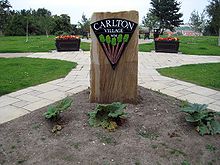- Rhubarb Triangle
-
The Rhubarb Triangle is a 9-square-mile (23 km2) triangle in West Yorkshire, England located between Wakefield, Morley and Rothwell famous for producing early forced rhubarb. It includes Kirkhamgate, East Ardsley, Stanley, Lofthouse and Carlton.[1] The Rhubarb Triangle was originally much bigger covering an area between Leeds, Bradford and Wakefield.[2] From the first decade of the 20th century to 1939 the rhubarb industry expanded and at its peak covered an area of about 30-square-mile (78 km2).[3]
Rhubarb is a native of Siberia and thrives in the wet cold winters in Yorkshire. West Yorkshire once produced 90% of the world's winter forced rhubarb from the forcing sheds that were common across the fields in the area.[4]
In February 2010, Yorkshire Forced Rhubarb was awarded Protected Designation of Origin (PDO) status by the European Commission’s Protected Food Name scheme after being recommended by Department for Environment, Food and Rural Affairs, (Defra).[5]
Contents
Cultivation
The cultivation method for forced rhubarb was developed in the early 1800s.[6] The fields were fertilised with large quantities of horse manure and 'night soil' from the nearby urban areas as well as woollen waste from "mungo and shoddy" mills.[7]
The rhubarb plants spend two years out in the fields without being harvested. There, they store energy from the sun in their roots as carbohydrates before they are transferred into the sheds in November where they are planted and kept in complete darkness. The roots are subjected to frost before being moved inside. In the sheds the plants begin to grow in the warmth and the stored carbohydrate is transformed into glucose resulting in forced rhubarb's bittersweet flavour.[8] The sheds are long low buildings which are heated; originally this was done with coal, which was plentiful and relatively cheap in the area. Diesel has replaced coal for heating the sheds.[9]
Forced rhubarb grown in these sheds is more tender than that grown outdoors in summer. Without daylight the rhubarb leaves are an anaemic green-yellow, and the 2-foot (61 cm) long stalks smooth textured and crimson. Traditionally the pickers pull the stalks in candlelight as any exposure to strong light will stop the growth. By the end of March the harvest is over and the root stock is totally exhausted and used for compost.[9]
History
The growing and forcing was originally done by many hundreds of small farmers, smallholders and market gardeners. In later years some growers expanded and owned many thousands of roots and extensive forcing sheds.[3] In the late 19th century early forced rhubarb was sent to Spitalfields and Covent Garden markets in London in time for Christmas and was sent to Paris for the French market. A special express train carrying rhubarb was run by the Great Northern Railway Company from Ardsley station every weekday night during the forced rhubarb season from Christmas until Easter. Up to 200 tons of rhubarb sent by up to 200 growers were carried daily at the peak of production before 1939.[6] In 1962 a rail strike caused the growers to look for alternative transport and the service ended shortly after.[3] Rhubarb became less popular after the Second World War when more exotic fruits became more available.[4]
The 12 farmers who farm within the Rhubarb Triangle applied to have the name Yorkshire forced rhubarb added to the list of foods and drinks that have their names legally protected by the European Commission’s Protected Food Name scheme.[10] The application was successful and the farmers were awarded Protected Designation of Origin (PDO) in February 2010. Food protected status means European funding to promote the product and legal backing against other products made outside the area using the name. Other protected names include Stilton cheese, Champagne and Parma Ham. Leeds Central MP and Environment Secretary, Hilary Benn, was involved in the Defra campaign to win protected status.[11][12]
The Oxford English Dictionary dates the name "Rhubarb Triangle" to the Guardian newspaper in 1986[13] but it was mentioned in a 1965 textbook.[14]
Culture
Wakefield Council holds an annual Rhubarb Festival in February, celebrating the area's links and promoting the surviving rhubarb industry. A Farmers' Market, cookery demonstrations, walks and tours of the forcing sheds are among the attractions.[1][15] In 2005 Wakefield council erected a sculpture depicting a rhubarb plant in Holmfield Park Wakefield.[16]
References
- Notes
- ^ a b Markham 2005, p. 118
- ^ Map of the Week, BBC.co.uk, http://www.bbc.co.uk/blogs/thereporters/markeaston/2010/02/the_rhubarb_triangle.html, retrieved 2010-03-04
- ^ a b c Rhubarb Triangle, Morley Archives, http://www.morleyarchives.org.uk/p_rhubarb.html, retrieved 2010-02-21
- ^ a b Working Lunch, BBC.co.uk, 2006-02-07, http://news.bbc.co.uk/1/hi/programmes/working_lunch/4685636.stm, retrieved 2010-02-21
- ^ EU name status, BBC.co.uk, 2010-02-25, http://news.bbc.co.uk/1/hi/england/bradford/8536833.stm, retrieved 2010-02-25
- ^ a b Jack, Ian (2008-01-18), Food and Drink, London: Guardian, http://www.guardian.co.uk/uk/2008/jan/19/lifeandhealth.foodanddrink, retrieved 2010-02-21
- ^ (PDF) A Shoddy Tale, Watsonia.org, p. 2, http://www.watsonia.org.uk/Wats26p127.pdf, retrieved 2010-02-21
- ^ Mackay, Mairi (2008-01-19), Rhubarb, London: Times Online, http://www.timesonline.co.uk/tol/life_and_style/food_and_drink/real_food/article1358524.ece, retrieved 2010-02-21
- ^ a b Forced rhubarb, Brandy Carr Nurseries, http://www.brandycarrnurseries.co.uk/rhubarb/forced-rhubarb.htm, retrieved 2010-02-21
- ^ (PDF) Application to register Yorkshire Forced Rhubarb, DEFRA, http://www.defra.gov.uk/foodfarm/food/industry/regional/foodname/products/documents/indoor-yorks-rhubarb-pdo.pdf, retrieved 2010-02-25
- ^ Yorkshire rhubarb joins Europe’s protected food elite, DEFRA, http://www.defra.gov.uk/news/2010/100225b.htm, retrieved 2010-02-25
- ^ Bates, Stephen (2010-02-25), European Protection, London: Guardian, http://www.guardian.co.uk/business/2010/feb/25/yorkshire-forced-rhubarb-eu-protection, retrieved 2010-02-25
- ^ "Rhubarb Triangle", Oxford Oxford English Dictionary Third Edition, http://www.oed.com/view/Entry/165353, retrieved 10 November 2010
- ^ Robinson 1965, p. 128
- ^ Rhubarb Festival, Wakefield Council, http://www.wakefield.gov.uk/CultureAndLeisure/RhubarbFestival/default.htm, retrieved 2010-02-21
- ^ Bell 2009, p. 28
- Bibliography
External links
Categories:- Geography of Bradford
- Geography of Leeds
- Geography of Wakefield
- British products with protected designation of origin
Wikimedia Foundation. 2010.



